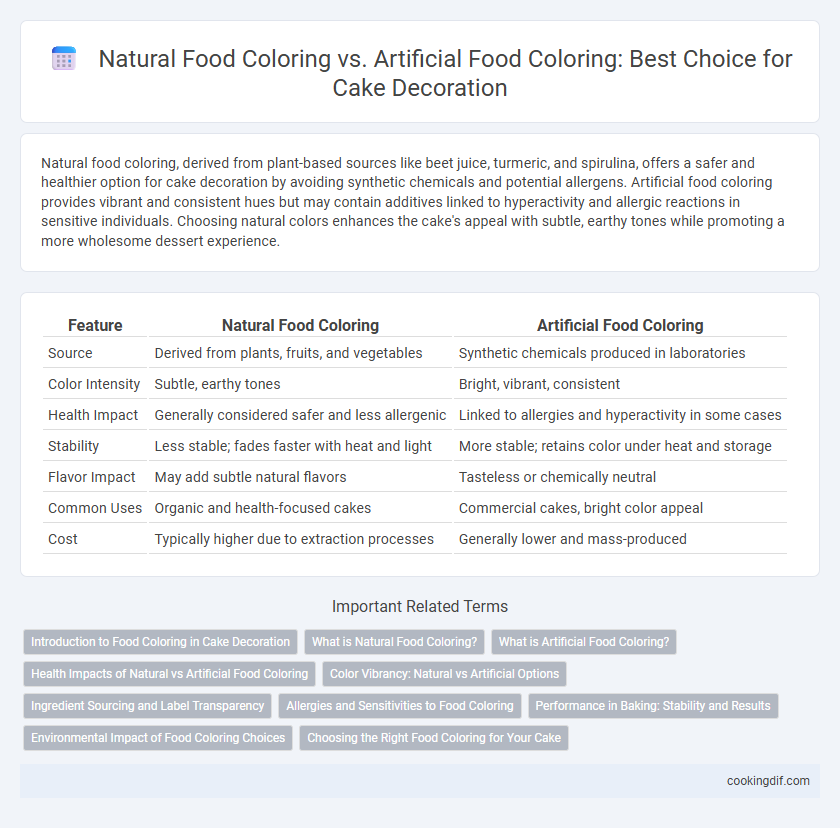Natural food coloring, derived from plant-based sources like beet juice, turmeric, and spirulina, offers a safer and healthier option for cake decoration by avoiding synthetic chemicals and potential allergens. Artificial food coloring provides vibrant and consistent hues but may contain additives linked to hyperactivity and allergic reactions in sensitive individuals. Choosing natural colors enhances the cake's appeal with subtle, earthy tones while promoting a more wholesome dessert experience.
Table of Comparison
| Feature | Natural Food Coloring | Artificial Food Coloring |
|---|---|---|
| Source | Derived from plants, fruits, and vegetables | Synthetic chemicals produced in laboratories |
| Color Intensity | Subtle, earthy tones | Bright, vibrant, consistent |
| Health Impact | Generally considered safer and less allergenic | Linked to allergies and hyperactivity in some cases |
| Stability | Less stable; fades faster with heat and light | More stable; retains color under heat and storage |
| Flavor Impact | May add subtle natural flavors | Tasteless or chemically neutral |
| Common Uses | Organic and health-focused cakes | Commercial cakes, bright color appeal |
| Cost | Typically higher due to extraction processes | Generally lower and mass-produced |
Introduction to Food Coloring in Cake Decoration
Natural food coloring in cake decoration is derived from plant-based sources like beet juice, turmeric, and spirulina, offering vibrant hues without synthetic additives. Artificial food coloring, synthesized from chemical compounds, provides a broader spectrum of intense and consistent colors that enhance cake aesthetics. Choosing between natural and artificial options impacts not only the visual appeal but also the health considerations and ingredient transparency in cake decoration.
What is Natural Food Coloring?
Natural food coloring for cake decoration is derived from plant-based sources such as fruits, vegetables, and spices, offering a safer and healthier alternative to synthetic dyes. Common examples include beet juice for red, turmeric for yellow, and spirulina for green, providing vibrant colors without harmful chemicals. These natural pigments retain antioxidants and nutrients, making them ideal for creating visually appealing and nutritious cakes.
What is Artificial Food Coloring?
Artificial food coloring, also known as synthetic dye, consists of chemical compounds derived from petroleum or coal tar sources used to impart vibrant hues to cake decorations. These colorants offer consistent intensity and a wide palette unavailable in natural alternatives, making them popular in mass-produced baked goods. However, concerns over potential health risks and regulatory limits have prompted scrutiny and a rise in demand for natural food coloring options in cake decoration.
Health Impacts of Natural vs Artificial Food Coloring
Natural food coloring derived from fruits, vegetables, and spices contains antioxidants and fewer synthetic chemicals, reducing the risk of allergic reactions and hyperactivity in children. In contrast, artificial food coloring often contains petrochemical derivatives linked to behavioral issues, potential carcinogens, and increased risk of allergies. Choosing natural dyes for cake decoration promotes healthier consumption without compromising vibrant colors or visual appeal.
Color Vibrancy: Natural vs Artificial Options
Natural food coloring derived from fruits, vegetables, and spices offers subtle, earthy hues that enhance cake decoration with a wholesome appeal, though it often lacks the intense vibrancy found in artificial alternatives. Artificial food coloring, made from synthetic dyes like FD&C Red No. 40 and Blue No. 1, provides bright, consistent, and bold colors that remain stable under various baking conditions, ensuring visually striking cake designs. Choosing between natural and artificial colorants involves balancing color vibrancy against ingredient purity, with artificial colors delivering superior intensity and longevity for decorative cakes.
Ingredient Sourcing and Label Transparency
Natural food coloring for cake decoration is derived from plant-based sources like beet juice, turmeric, and spirulina, offering clear ingredient sourcing that appeals to health-conscious consumers. Artificial food coloring, typically synthesized from petroleum products and chemical compounds, often has less transparency on labels, raising concerns over potential allergens and additives. Clear labeling of natural colorants supports informed choices and reinforces trust in product safety and quality.
Allergies and Sensitivities to Food Coloring
Natural food coloring, derived from sources like fruits, vegetables, and spices, is often recommended for cake decoration due to its lower risk of triggering allergies and sensitivities. Artificial food colorings, such as Red 40 and Yellow 5, have been linked to allergic reactions, hyperactivity in children, and intolerance in sensitive individuals. Choosing natural dyes can minimize adverse effects and provide a safer option for those prone to food-related sensitivities.
Performance in Baking: Stability and Results
Natural food coloring offers moderate stability in baking, sometimes fading or altering flavor under high heat, whereas artificial food coloring typically maintains vibrant hues and consistent results even after prolonged exposure to oven temperatures. Natural dyes, derived from ingredients like beet juice or turmeric, may result in uneven coloration, while synthetic dyes provide uniform and predictable color intensity. Bakers seeking reliable, lasting decoration effects often prefer artificial colorants for their superior heat tolerance and color retention.
Environmental Impact of Food Coloring Choices
Natural food coloring for cake decoration is derived from plant-based sources, resulting in lower environmental impact due to renewable raw materials and reduced chemical processing. Artificial food coloring involves synthetic compounds that require energy-intensive production and generate more pollution and hazardous waste. Choosing natural colorants contributes to sustainable cake decorating by minimizing carbon footprint and supporting eco-friendly agriculture.
Choosing the Right Food Coloring for Your Cake
Natural food coloring for cake decoration offers vibrant hues derived from plant-based sources like beet juice, turmeric, and spirulina, providing a healthier alternative free from synthetic chemicals. Artificial food coloring delivers more intense, consistent colors that enhance the visual appeal but may contain additives linked to allergic reactions or hyperactivity in sensitive individuals. Selecting the right food coloring depends on balancing health considerations, color vibrancy, and cake design requirements to achieve the desired aesthetic effect.
Natural food coloring vs Artificial food coloring for cake decoration Infographic

 cookingdif.com
cookingdif.com